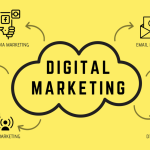Targeting the youth market as part of your digital marketing strategy involves more than sprinkling your content with buzz words or partnering with the latest Gen Z influencer.
Effective youth marketing involves strategically analyzing why your brand should reach out to younger generations, and developing tactics to do this effectively.
Each generation is different and has different interests and pain points, so it’s important to understand what makes each one tick from Baby Boomers to Gen Alpha (and the just-born Gen Beta!)
So let’s take a deep-dive into how to position your brand to appeal to younger generations.
- What is youth marketing?
- Why is marketing to youth important?
- Key benefits of youth marketing
- 10 key characteristics of youth marketing
This blog is based on our recent Marketing to the Next Generation webinar with Jane McDaid.
What is youth marketing?
Here’s an overview of the different generations in digital marketing terms, starting with the youngest. These are the broad characteristics of each generation:
- Generation Alpha (born 2010–2024): These are highly tech-savvy, having grown up with voice assistants, tablets, and digital ecosystems.They are arguably the generation most impacted by the Covid-19 pandemic.
- Generation Z (born 1997–2009): These tend to be diverse, socially conscious, and entrepreneurial. They were the first smartphone generation and are heavy users of social media. They are also known as ‘Zoomers’.
- Generation Y / Millennials (born 1981–1996): They witnessed the rise of the internet, social media, and mobile devices, and are adaptable, experience-focused, and value-driven.
- Generation X (born 1965–1980): Although they grew up with analog technology, they adapted to digital advancements. They tend to be independent, skeptical, and resourceful.
- Baby Boomers (born 1946–1964): These were born after the post-war ‘baby boom’, and grew up with traditional media, such as TV and radio. However, they adopted digital technology later in life.
The newest additions are known as Generation Beta, born between 2025 and 2040.
Note: In this blog, we’ll focus on marketing to Gen Z and Gen Alpha.
Social Media Calendar Template 2025
- ↗Generate great content ideas
- ↗Plan & schedule campaigns in advance
- ↗Leverage key dates & trends
- ↗Boost influencer or creator partnerships
Get my free calendar
Why is marketing to youth important?
The first question you need to ask is: Are young people my brand’s target demographic? If you’re selling a product or service that’s unlikely to appeal to youth (such as mortgages or vintage cars), then it doesn’t make sense to invest in expensive campaigns that are unlikely to lead to conversions.
Top tip: When developing any digital marketing strategy, it’s essential that you know your audience.
On the other hand, if young people could constitute a segment that you engage with, then targeting this highly influential and future-oriented demographic brings several benefits.
Consider these statistics:
- 91% of Gen Z social media users are on Instagram.
- 86% of Gen Z social media users are on TikTok.
- When they want to discover products, most Gen Z social media users use TikTok.
- Short-form video is the most popular type of brand content on TikTok and Instagram among Gen Z.
- 89% of Gen Alpha TikTok users scroll through short-form content on a daily basis.
Key benefits to youth marketing
- Long-term customer loyalty: Younger consumers are more likely to stick with brands they connect with during formative years. For example, Nike targets a lot of its products and messaging at younger people, and partners with influencers that this demographic respects.
- Trendsetting: Younger generations are cultural trendsetters, shaping broader consumer behaviors and preferences.
- Social media skills: Young people dominate platforms like TikTok, Instagram, and YouTube, providing direct access to a highly engaged audience and opportunities for organic reach.
- Early adoption of technology: Younger consumers are eager adopters of new technology and innovations. They provide valuable feedback for optimizing products, features, and user experiences.
- Creativity and engagement: Younger audiences respond well to interactive and creative campaigns, such as gamification, augmented reality (AR), and experiential marketing. This can help to amplify campaigns through shares, likes, and discussions.
- Openness to new ideas: Younger generations are more open to discovering and adopting new brands. They embrace innovation and are willing to experiment with unique, disruptive products.
- Advocacy and social awareness: Younger consumers are vocal about social, environmental, and political issues. Aligning your brand with values such as sustainability, diversity, and inclusivity can encourage them to advocate for your brand.
- Multi-channel engagement: Younger people tend to engage with brands across multiple channels, from social media to gaming and online communities. This multi-platform behavior provides opportunities for deeper engagement and storytelling.
” The first thing we have to do is to recognize the value that young people put on their own personal identity. “– Jane McDaid, Thinkhouse
10 key characteristics of youth marketing
Youth marketing aims to understand the behaviors and attitudes of young people, and then focus on what really matters to them. And this involves trying to understand what it is like to be young today. To do this, you need to analyze their point of view.
So, where to start?
- Recognize the value that young people put on their own personal identity.
- Appreciate that youth culture today is internet culture – each of them informs and influences the other.
- Know that understanding their wider outlooks and their behaviours (online and offline) is key to cultural relevance – and key to marketing to this generation.
This puts you in a position to ‘FEED THE FEED’. If you show up on their social media feeds, you’re one step closer to unlocking business opportunities.
One of the challenges of youth marketing is that it’s different being young today than it was even last week. It’s likely that the values and perspectives of young people today will be vastly different from the youth audiences of tomorrow!
This is why it is worth investing in qualitative and quantitative research to better understand the unique behaviors, attitudes, and life stages of young audiences.
Use behavioral data to define audience archetypes. You can then target based on interests and actions, rather than age alone. Then select the marketing channels and social media platforms that align with your audience’s preferences.
How can you tune in to the young people in your target audience? Here are our ten top characteristics of the youth point of view:
- Youth culture is the creator economy
- Young people expect speed, savviness, and smarts
- TikTok is the shopping channel
- Influencers act as digital filters
- The internet removes geographic boundaries
- Consider the lifestyle your brand wants to be associated with
- Replicable visual signatures are branding gold
- Experiences are rooted in sensorial marketing
- Bring your values to the fore to capture youth attention
- Communities built online are being celebrated offline
1. Youth culture is the creator economy
Young people see themselves as online content creators and influencers, heavily shaped by their peers and family. They crave acceptance and validation, often earning social currency by being ‘in the know’ on all things trending.
Pop culture has evolved into a creator economy, with teens positioning themselves as trendsetters – sharing hidden gems, trying new things, and offering sharp commentary to influence others.
They love introducing friends to new experiences, making social content a key tool for connection. This can be a great opportunity for your brand to increase its reach through word of mouth.
Ask yourself: How can you play into young people’s desire to create and their desire to influence?
Examples:
- Trying new things
- Visiting new restaurants
- Sharing product empties
2. Young people expect speed, savviness, and smarts
As digital natives, young people value speed, savviness, and smarts in their online experiences.
Speed
They expect fast, hassle-free interactions with brands – whether it’s booking online, pre-ordering drinks, or quick product deliveries. The rise of drone delivery services like Amazon in the US or Manna in Ireland reflects their growing demand for speed.
Savviness
Tech-savvy and organized, they use tools like Google Maps to save and share locations, or Instagram Folders to collaborate with friends on plans for dinners, holidays, or events. They know how to curate and share their digital wishlists seamlessly.
Smarts
Young people love tools that offer multiple benefits at once. Apps like Too Good To Go appeal to them by combining savvy deals with sustainability (reducing food waste). In today’s cost-of-living crisis, they’re also experts at finding the best deals, embracing ‘dupe culture’, and seeking affordable alternatives to premium brands.
To meet their expectations, brands must deliver seamless, efficient, and innovative digital experiences.
Examples
The Too Good to Go app alerts people when there’s food for sale locally at a discount because it’s near its expiry date. This is very popular with the next generation and is a good example of how savvy they are. Not only are they saving money by using this tool, they’re also avoiding food waste!
Pandabuy is another example of savvy spending. Young people like to search online and find the best deals. This has led to the rise of ‘dupe’ shopping, where people buy cheap fake alternatives to expensive designer brands.
3. TikTok is the shopping channel
” Don’t be cringe! Strike a balance between doing it at the right time and in the right way. “– Jane McDaid
Example
BookTok is a very popular TikTok trend (also found on YouTube as BookTube). Creators who focus on reading books have had such an influence over people’s reading habits that the publishing industry has seen something of a disruption. This also reflects a shift away from screen time and a return to reading traditional books.
4. Influencers act as digital filters
Despite their savviness, young people often face content overload. This is where niche influencers, or ‘cultural editors’, step in. These creators curate the best of the internet, helping their followers filter out the noise and focus on what’s worth their attention.
As the creator economy evolves, influencers are refining their niches and establishing authority within specific markets. Young people increasingly rely on these curators to guide them, making it crucial for brands to collaborate with influencers to appear in the right social media feeds.
Example
James Hoffman has become a very popular niche influencer. He was a World Barista Champion in 2007 and now what his content is all around is sharing coffee knowledge. He talks not just about the coffee itself, but all the paraphernalia that surrounds that coffee. So this is the area that he owns as a creator and influencer.
5. The internet removes geographic boundaries
Geographical boundaries don’t exist when it comes to influence. As Jane notes, “Good content is good content. It doesn’t matter where it starts out. If it’s telling us something as a worldwide audience, that content is going to speak to us.”
Brands that are born in a local market can now explode online and suddenly become global. Brands now need to be ready for this sudden growth by ensuring that they are capable of growing at scale.
Example
K-Beauty is a very popular Korean skincare brand. It established Korea as the world’s leading skincare geography after the brand surged as a result of everything that was on TikTok. This is a great example of a brand that was born to cater for a local market becoming a global phenomenon.
6. Consider the lifestyle your brand wants to be associated with
This generation of young people is the most health-literate generation yet. They reject stressful, ‘heavy’ lifestyles and seek out healthy alternatives. As Jane notes, “Healthy for a lot of young people is not just ‘healthy’. It’s trendy, it’s cool, and it’s fun. But it’s not puritanical.”
This aesthetic has also, paradoxically, led to the popularity of ‘unhealthy’ lifestyle choice. So the brands that are winning are those that are delivering novel experiences on both sides of the health spectrum.
The brands thriving with youth are those offering fresh, novel experiences across both ends of the health spectrum, all while embracing a lifestyle aesthetic that resonates. If your brand can balance health, aesthetics, and lifestyle appeal, you’ll win over this market.
Example
The Mukbang trend is where people post videos of themselves consuming junk food. It explores the guilty pleasures of consuming unhealthy food. For example, people livestream themselves consuming Raising Cane’s fast casual food. If you’re in that food and drink space, consider how your brand could show up in this world.
7. Replicable visual signatures are branding gold
In a digital world where short-form videos are increasingly coming out on top, visual signatures are the key to brand resonance. These are simple visual elements that can be easily identified and emulated. They can be made up of many elements: color palette, logo, icons, typography, images.
If your brand can create a striking visual signature that not only resonates with the youth market, but is easily replicable, it could soon become a real brand asset.
By staying relevant, interactive, and aligned with youth values, brands can leverage their visual identity to create a strong, lasting impact on young consumers.
Example
Charli XCX inspired an online sensation through her 2024 Brat album. The so-called ‘brat summer’ was built around the vibrant green album color and became a celebration of positive vibes and carefree lifestyles and was notably picked up by the Harris election campaign. Interestingly, Charli XCX herself wrote the creative brief and chose the iconic visual signature.
8. Experiences are rooted in sensorial marketing
Gen Z and Gen Alpha are highly creative generations that wish to be immersed in experiences, with all senses engaged. Remember, this is the generation that grew up with ASMR (autonomous sensory meridian response) content on their phones.
What does this mean for brands? You need to think about using all five senses (sight, sound, touch, smell, taste, and feel) to improve the brand’s ‘vibration’.
You could create virtual reality experiences that engage multiple senses. Or you could tell a story about your brand, again appealing to many senses. Include the details that bring the story to life. It could even involve creating immersive art experiences around your brand!
Examples
Mr. Foggs Society of Exploration offers a multi-sensory re-creation of the experience of a traditional Victorian pub. As well as savoring a range of food and drinks, customers can immerse themselves in a bygone age.
” Bringing that sensorial experience to your brand gives this generation something more to experience, something more to talk about. “– Jane McDaid
9. Bring your values to the fore to capture youth attention
Today’s youth audiences are very literate when it comes to issues and causes to care about, recognizing the power their purchasing decisions hold. They are aware that their spending can drive positive or negative change, and they understand their collective influence to elevate or dismantle a brand. With access to a wide range of online political commentators – often from diverse perspectives and not always factually accurate – they act with intention and discernment.
Tailor your messaging to align with issues, values, or experiences that directly impact young people’s lives. And build trust with open, honest communication. Remember, younger audiences value brands that stand for clear principles.
Because they are so careful with their money, they think before they spend. They don’t just consider the cost of the product. They know that their wallets can impact for good, but they can also impact for bad. And they understand this power can make or break a brand as well.
When targeting this audience, it’s important for a brand to show that your values align with the social issues that young people care about. For example, how can your brand show its sustainability credentials or its commitment to ethical supply chains? What charities and local suppliers should you support? And how can you show how that can help young people to live their values?
However, try to do it in an engaging way that will appeal to younger people. You don’t have to be all sanctimonious about it!
Example
Several companies have partnered with charities in order to enhance their brand reputation and demonstrate how they ‘live their values’. For example, Vinted, the secondhand marketplace, has partnered with Oxfam and created a runway that featured Vinted’s content creators and influencers as models. This showcased potential in secondhand clothes and helped to grow that clothing industry.
10. Communities built online are being celebrated offline
There’s a real appetite among younger people for community. They want to meet new people and to feel part of something new. Especially since the Covid-19 pandemic, there’s been a growing demand for more in-person, offline interactions – though these often extend into the online world afterward.
Brands have succeeded in hosting in-person meetups for many types of niches to foster communication, from fandoms to fitness, and quite often… food. Find out what really matters to your target audience and build communal experiences around that. Look for trends or movements already resonating with youths and then amplify them to foster a sense of belonging.
These in-person gatherings also tap into the desire for offline activity. Although social media and online experiences are hugely important to younger people, there has also been a trend towards ‘digital detoxes’ (including even deleting social apps from phones) and savoring the offline experience.




